Saturday, November 30, 2019
Yojana Magazine November 2019 (English) Pdf Download
VisionIAS
00:01
Yojana Magazine November 2019 (English) Pdf Download
Click Here to download Yojana Magazine November 2019 (English) Pdf
Click Here to Like our Facebook page for latest updates and free ebooks
Click Here to download Yojana Magazine November 2019 (English) Pdf
Click Here to Like our Facebook page for latest updates and free ebooks
Friday, November 29, 2019
Daily Current Affairs, 29th November 2019
VisionIAS
23:52

1) International Day of Solidarity with the Palestinian People: 29 November
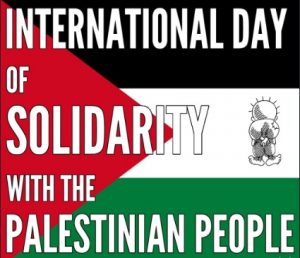
•The International Day of Solidarity traditionally provides an opportunity for the international community to focus its attention on the fact that the question of Palestine remains unresolved and that the Palestinian people have yet to attain their inalienable rights as defined by the General Assembly, namely, the right to self-determination without external interference, the right to national independence and sovereignty, and the right to return to their homes and property, from which they have been displaced.
2) India to host 2023 Men’s Hockey World Cup
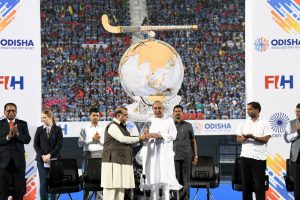
•Bhubaneswar has hosted some big international sporting events, including the 2017 Asian Athletics Championships, 2017 FIH Hockey World League Final, FIH Men’s Series Finals in 2019 and the recently-concluded FIH Hockey Olympic Qualifiers.
3) Rajnath to inaugurate 3rd edition of Military Literature Festival
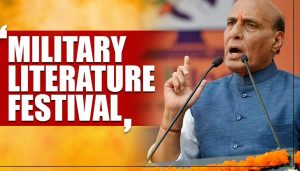
•The 10 books of noted defence and literary authors would also be released on occasion. This year, the event would commemorate Indian participation in the Burma Campaign in World War II, the 75th anniversary of which falls next year.
4) EU Parliament declares climate emergency
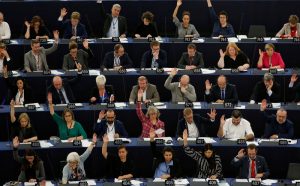
•The climate declaration was passed in Strasbourg during a European Parliament debate on the upcoming United Nations’ COP25 climate summit. The summit kicks off on 2nd December in Madrid. EU lawmakers urged the European Commission to fully ensure all relevant legislative and budgetary proposals are fully aligned with the 1.5-degrees-Celsius target limit on global warming. The resolution calls on the EU to cut emissions by 55 per cent by 2030 to become climate neutral by 2050.
5) ISRO transfer space-grade Li-Ion cell technology to BHEL

•BHEL can also produce and sell Li-Ion cells for meeting other national/commercial applications by suitably modifying the space-grade cell which can lead to cost reduction. BHEL is in the process of establishing the Li-Ion production facility near Bangalore in Karnataka.
6) Indian Army successfully test-fired 2 Spike LR missile in MP
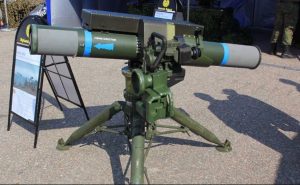
•The Indian Army has successfully test-fired 2 Spike long-range anti-tank missiles at Mhow in Madhya Pradesh. Spike is a 4th-generation missile which can engage any target with precision at ranges up to 4 km. India became the 33rd country to have the Spike missile as part of its inventory. The missile has the ability to fire, observe and update, providing substantial flexibility to the firer to pinpoint the impact point. It also has the ability to switch to a different target mid-flight. The firer has the option of firing from a low or high trajectory.
7) G K Reddy inaugurates 1st Intl. Conf on “Landslides Risk Reduction and Resilience”
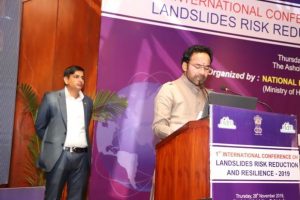
8) MHRD launches 3 books for children namely Kumbh, Garam Pahad and Dilli ki Bulbul
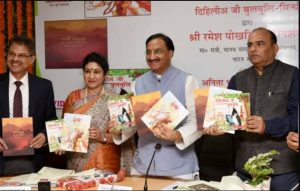
9) Tata Comm board appoints A S Lakshminarayanan as MD and CEO

10) Moody’s expects Centre’s fiscal deficit to rise to 3.7%

•A fiscal deficit is a shortfall in a government’s income compared with its spending. It is calculated as a percentage of GDP, or simply as total dollars spent in excess of income.
The HINDU Notes – 29th November 2019
VisionIAS
12:58

📰 Sri Lankan President Gotabaya Rajapaksa arrives in New Delhi on two-day visit, to meet PM Modi on November 29
On November 29, Gotabaya Rajapaksa will hold extensive talks with Prime Minister Narendra Modi
•Sri Lanka’s newly elected President Gotabaya Rajapaksa, who on Thursday arrived in New Delhi on his maiden state visit abroad, will meet Indian Prime Minister Narendra at noon Friday. He will later call on President Ram Nath Kovind, according to the Ministry of External Affairs.
•Colombo-based officials said national and regional security, development cooperation and economic assistance are likely to come up at the high-level bilateral discussion that comes a fortnight after Mr. Rajapaksa clinched presidency.
•The visit also follows India’s particularly swift outreach to the region’s newest leader. Mr. Gotabaya, a military man-turned-bureaucrat, entered politics with a presidential bid and won with a decisive mandate. External Affairs Minister S. Jaishankar, the first foreign official to call on him, flew to Colombo as Prime Minister Narendra Modi’s envoy, hours after Mr. Gotabaya formally assumed charge.
•Presidential adviser Lalith Weeratunga, who is on the Sri Lankan delegation to India, said Mr. Jaishankar’s visit signalled a “new beginning” in the ties. “The President [Mr. Rajapaksa] is really looking forward to this visit [to New Delhi].”
•National security, a “top priority” for the President, would likely be discussed at length, Mr. Weeratunga said. “The President is also keen that any impediment to Indian investment be ironed out. He is very focussed on every aspect of the partnership with India and wants to look at our close ties in a holistic manner,” Mr. Weeratunga told The Hindu before his departure.
Spotlight on Tamil issue
•Sri Lanka’s Tamil leadership and people are closely following the visit, especially since the Ministry of External Affairs (MEA) said after Mr. Jaishankar’s visit that New Delhi “expects” Sri Lanka to take forward its post-war reconciliation process, ensuring “equality, justice, peace and dignity” of the Tamil people.
•Veteran Tamil leader R. Sampanthan said he expected Mr. Rajapaksa’s visit to “make a positive contribution” to better relations between the neighbours. “Better relations will be facilitated by India’s concerns being addressed in regard to the process of reconciliation and the resolution of the national question in Sri Lanka,” he told The Hindu, expressing the hope that both governments would ensure that the past promises to the Tamils were kept.
•Referring to Mr. Modi’s recent remarks that the Constitution was “a guiding light”, Mr. Sampanthan said: “We too look upon the Constitution as the guiding light of our present journey. Our new constitution must be enacted without any further delay, as it will light up the path of Sri Lanka’s journey towards, peace, prosperity and progress for all its people.”
•The outgoing government could not complete the proposed constitution, despite its drafters tabling an interim report in Parliament based on wide consultations. It remains to be seen if devolution of powers to the Tamils, or more broadly a political solution through constitutional reforms, will figure at Friday’s discussions.
•Before his departure, Mr. Gotabaya tweeted: “Leaving for my first state visit to India and looking forward to strengthening bilateral relations with Shri @narendramodi and Govt of India”.
•Following his arrival in New Delhi, MEA spokesperson Raveesh Kumar tweeted: “A civilisational relationship nurtured through millennia President @GotabayaR on his first overseas visit since assuming office arrives in India on a State visit at PM @narendramodi’s invitation, demonstrating the strength & dynamism of [India-Sri Lanka] relations. #NeighbourhoodFirst”.
📰 Nod for defence purchase worth Rs. 22,800 cr.
The HINDU Notes – 28th November 2019
VisionIAS
12:58

📰 SPG Bill passed amid Opposition walkout
Former PMs to get cover for 5 years
•The Lok Sabha on Wednesday passed the Special Protection Group (Amendment) Bill, 2019 which will now protect only the Prime Minister and members of his immediate family residing with him at his official residence.
•It will also provide security to former Prime Ministers and their immediate family members staying with them at the residence allotted for a period of five years from the date on which they cease to hold office.
•The Opposition walked out during the voting on the Bill.
•Replying to the debate in the Lower House, Home Minister Amit Shah said that with this amendment, his government would restore the original intent of the Act, which was to provide security for the Prime Minister.
•He said: “The people of the country should know that the security of Congress president Sonia Gandhi and her children Rahul and Priyanka has not been withdrawn but changed to ‘Z-plus’ with advance security liaison and ambulance that will be given across the country.”
•Refuting any charges of the move being a “political vendetta”, Mr. Shah said: “The BJP does not carry out any action with a vindictive approach. It was the Congress which took many such decisions in the past. The term ‘special’ indicates its [the Special Protection Group’s] special purpose. Many countries have such elite and compact cover exclusively for their respective heads of state.”
•He said that when the SPG cover of former Prime Ministers Chandra Shekhar, I.K. Gujral and Manmohan Singh was withdrawn, “no one uttered a word”.
•Opposing the Bill, MP N. K. Premachandran said: “If there is any security threat, they [former PMs] have to be protected. Kindly don’t play politics in this issue.”
•Raja of the Dravida Munnetra Kazhagam claimed that the amendment was being undertaken for political reasons.
•Replying to the debate in the Lower House, Home Minister Amit Shah said that with this amendment, his government would restore the original intent of the Act, which was to provide security for the Prime Minister.
•He said: “The people of the country should know that the security of Congress president Sonia Gandhi and her children Rahul and Priyanka has not been withdrawn but changed to ‘Z-plus’ with advance security liaison and ambulance that will be given across the country.”
•Refuting any charges of the move being a “political vendetta”, Mr. Shah said: “The BJP does not carry out any action with a vindictive approach. It was the Congress which took many such decisions in the past. The term ‘special’ indicates its [the Special Protection Group’s] special purpose. Many countries have such elite and compact cover exclusively for their respective heads of state.”
•He said that when the SPG cover of former Prime Ministers Chandra Shekhar, I.K. Gujral and Manmohan Singh was withdrawn, “no one uttered a word”.
•Opposing the Bill, MP N. K. Premachandran said: “If there is any security threat, they [former PMs] have to be protected. Kindly don’t play politics in this issue.”
•Raja of the DMK claimed that the amendment was being undertaken for political reasons.
📰 Caught in the Act: On Transgender Persons Act
The HINDU Notes – 27th November 2019
VisionIAS
12:30

📰 The many faces of Pakistani Punjab’s militancy
Anti-India groups have selectively interpreted history to gain legitimacy among residents in the area
•The U.S. Congress’s just-released ‘Country Reports on Terrorism’ for 2018 has mentioned that Pakistan failed to “significantly limit” Punjab-based militant outfits like the Lashkar-e-Taiba (LeT) and the Jaish-e-Mohammed (JeM). Earlier, in September, speaking in Torkham, Pakistan Prime Minister Imran Khan had warned his countrymen against going to India to fight jihad, stating that such actions would amount to doing “injustice to Kashmiris”. Coming at the height of the war of words between the two countries, the statement was a rare admission by a Pakistani leader that infiltration from that side of the 740-km Line of Control, as well as the international border in Punjab, is a fact.
•Over the years, most of the Pakistani militants who crossed the border, and were caught by Indian security personnel, had one element in common — they were all from the Punjab province. Contemporary discussions on extremism originating from the province are mostly framed around the Pakistani military’s support to these extremist groups. However, there are many other variables rooted in the Pakistani Punjab’s society that also need to be understood.
The dominant province
•Punjab overshadows other provinces in Pakistan primarily due to its size, resources and representation in elite institutions. It can be broken into three broad sub-cultural units: the Punjabi-speaking eastern and central Punjab; the Pothwari-speaking northern Punjab that includes Rawalpindi and Islamabad; and the Saraiki-speaking southern Punjab.
•Eastern and central Punjab is linguistically akin to the Indian Punjab. The Kartarpur Corridor falls in this zone. Many of the residents there belong to families who had migrated from India during Partition. They are mostly settled in Lahore, Sialkot, Lyallpur (Faisalabad), Montgomery (Sahiwal) and Gujranwala. In his seminal book Pakistan: A Modern History, British historian Ian Talbot wrote, citing Pakistani academic Mohammad Waseem, that “the five million migrants [from the Indian side of the border] have both provided a major support for Islamist parties and shaped the Punjab province’s strong anti-India and pro-Kashmiri leanings.”
•In addition, a less-acknowledged fact in Partition studies is the massive outflow of Muslims from the plains of J&K, mostly the southern part i.e. Jammu, in 1947. The extent of that migration can be gauged from the changes in Census data. Jammu district’s Muslim population, which was 37% in 1941, came down to about 10% in 1961.
•According to the 1948 West Punjab Refugees Census, the number of Muslims who migrated from J&K, most of them from Jammu, was 2,02,600, the highest outside east Punjab. Muslims from Jammu plains mostly settled in areas around Sialkot and Lahore.
•These past events, along with the constant turbulence in J&K’s politics, are selectively interpreted by Punjab-based, Kashmir-centric terrorist outfits to gain legitimacy. In the last 30 years, LeT, claiming to be fighting on behalf of J&K, has mostly drawn recruits from the eastern and central areas of the Punjab. The Mumbai attacks terrorist Ajmal Kasab was from Okara district, located near the Indian border.
Seasonal water scarcity
•Another issue used by militants to gain support is that of seasonal water scarcity. The name ‘Punjab’ was derived from the Persian words panj (five) and ab (waters). The five rivers referred to here — Chenab, Jhelum, Beas, Sutlej and Ravi — flow through the Punjab’s territory. The Indus Waters Treaty stipulated that the waters of the three eastern rivers — Ravi, Beas and Sutlej — would be made available for unrestricted use by India. The waters of the three western rivers — Indus, Jhelum and Chenab — were allowed to flow for unrestricted use by Pakistan, except for some limited use by India such as for agricultural purposes and generation of hydroelectric power from run-of-the-river plants. Chenab and Jhelum, which enter Pakistan through J&K, are major sources of irrigation for Pakistan’s eastern agricultural fields.
•Whenever there is seasonal water scarcity, terrorist outfits such as LeT point fingers at India. The ‘jihad in Kashmir’ is presented as a necessity by organisations like the Jamaat-ud-Dawa (JuD) to save Punjab’s agriculture. In the past, Hafiz Saeed, LeT founder and alleged mastermind of the Mumbai attacks, has repeatedly tried rallying support of locals alleging that ‘India is in the process of constructing several dams on Chenab, Jhelum and Indus rivers in a bid to completely stop the flow of water towards Pakistan’.
•Northern Punjab is ethnically closer to Pakistan-occupied Kashmir and, prior to 1947, provided the main vehicular route to the Kashmir Valley from British India. Pakistan’s Railway Minister Sheikh Rashid, who J&K Liberation Front chief Yasin Malik once said provided property and assistance to an early batch of Kashmiri militants, is from this region.
•The third part of Pakistani Punjab, southern Punjab, has relatively less in common with the rest of the province. Outfits like JeM, which took responsibility for Pulwama attacks, originated in this part of the country. In 2003, nearly a year after the group was banned, it also made an unsuccessful bid to assassinate the then-President Pervez Musharraf, for which it recruited a resident of Rawalakot, PoK.
Political marginalisation
•A 2016 International Crisis Group paper, written exclusively on violent extremism in southern Punjab, had stated that among the reasons for support for militancy in the “rural and relatively poorly developed” part of the province were “political marginalisation, weak governance, economic neglect and glaring income inequity”.
•Another element, according to the paper, was the role played by economically poor Muslim migrants from India in the spread of a radical version of the Deobandi School of Islam. This, the paper said, was more pronounced in places like Jhang, “the birthplace of organised sectarian militancy in Pakistan”. The poverty of the Muslim migrants from India was “in marked contrast to the [prosperity of] large landowners in rural areas, who were mostly Shias and Barelvis and formed the political elite.” This could explain the growth of outfits like JeM, founded by Masood Azhar, born in south Punjab’s Bahawalpur, as Jaish claims adherence to the Deobandi School. Deobandi scholars in India have frequently criticised Pakistan-based groups for misappropriation of this school of Islam.
•There has been a long-standing demand for the creation of separate province of ‘south Punjab’ within the Saraiki belt. However, it remains to be seen whether greater decentralisation can be an antidote to extremism rooted in a supposed Deobandi interpretation of Islam.
•Hence, apart from dealing with the challenge posed by the deep state’s support for these outfits, we also need knowledge of the sociological and historical nuances pertaining to the Punjab province. Such an understanding is necessary to develop a holistic response to counter the extremist threat.
📰 The misadventure of a new citizenship regime
Prelims bits Compilation October 2019 BY ShankarIAS
VisionIAS
08:46
Prelims bits Compilation October 2019 BY ShankarIAS

Click Here to download Prelims bits Compilation October 2019 BY ShankarIAS
Click Here to Like our Facebook page for latest updates and free ebooks

Click Here to download Prelims bits Compilation October 2019 BY ShankarIAS
Click Here to Like our Facebook page for latest updates and free ebooks
Drishti IAS Prelims 2020 Test 2 English with Solution
VisionIAS
08:40
Drishti IAS Prelims 2020 Test 2 English with Solution

Click Here to download Drishti IAS Prelims 2020 Test 2 Question
Click Here to download Drishti IAS Prelims 2020 Test 2 Solution
Click Here to Like our Facebook page for latest updates and free ebooks

Click Here to download Drishti IAS Prelims 2020 Test 2 Question
Click Here to download Drishti IAS Prelims 2020 Test 2 Solution
Click Here to Like our Facebook page for latest updates and free ebooks
Drishti IAS Prelims 2020 Test 1 English with Solution
VisionIAS
08:38
Drishti IAS Prelims 2020 Test 1 English with Solution

Click Here to download Drishti IAS Prelims 2020 Test 1 Question
Click Here to download Drishti IAS Prelims 2020 Test 1 Solution
Click Here to Like our Facebook page for latest updates and free ebooks

Click Here to download Drishti IAS Prelims 2020 Test 1 Question
Click Here to download Drishti IAS Prelims 2020 Test 1 Solution
Click Here to Like our Facebook page for latest updates and free ebooks


